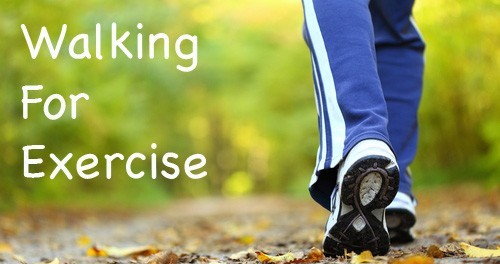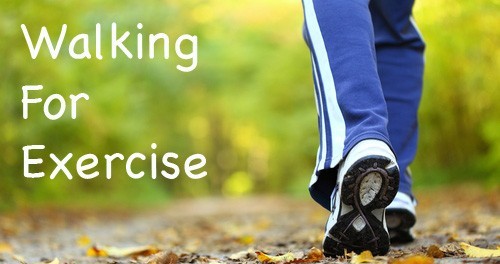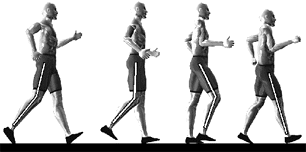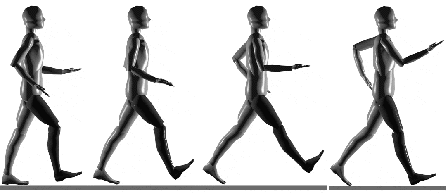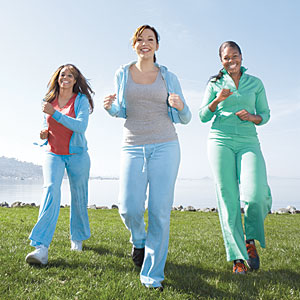Walk Talk Series
Day 10 – Foot Action and Keeping Hydrated
First we covered posture, then arm motion. Today, we find out what exactly to do with your feet.
You are probably thinking why would you need to learn how to walk, since you have been walking for a very long time now. The difference is when you sustain a walk for a long period of time with incorrect repetitive motion you can develop injuries, soreness, and slow you down. We don’t want you to stop walking now that you have established the habit. You may be surprised what you will learn in today’s lesson.
Walking Form – Knee & Foot Action
When learning new techniques, it is best if someone can watch you when you walk. However, it is often the case that a knowledgeable person or training partner is not available. So, use yourself as a coach. Walk in front of the glass storefronts, where you can watch yourself. Walk far enough away so you can see your whole body. Look to see if your leg is straightening and where your foot is hitting the ground. If you stand too close, your reflection will appear to pass by too quickly and you will accomplish little.
Knee Action
The knee must be straight from moment of heel contact until the support leg is in the vertical position (see figure below.) The knee is flexed in the recovery swing, since short pendulums swing faster. The point at which the rear leg starts to bend varies between individuals. The optimum point for it to bend depends upon structure, flexibility and strength of the walker.
WATCH FOR: The lead knee swinging through high. This is often due to a habit carried over from running (see figure below). This wastes energy and may lead to legality problems.
WATCH FOR: Bent knee on heel contact. Causes are over striding in front of the body, inadequate quadriceps strength and tight or weak hamstrings. Also Watch for The lead knee bending before the leg is vertically upright. For reasons as stated above. In addition, it may be caused by the walker trying to walk at speeds faster than their fitness level can sustain.
Foot Action
The heel strikes the ground first with the toes elevated, not flat footed. Once the foot has made contact, it rolls forward, keeping the toes off the ground until the leg is supporting the body’s weight. How long the toes are kept off the ground is directly related to the strength of the shin.
There is a push off with the calf causing the foot to roll to vertical, before leaving the ground. The foot of the swing leg is brought forward close to but not brushing the ground.
- Strike the ground first with your heel.

- Roll through the step from heel to toe.
- Push off with your toe.
- Bring the back leg forward to strike again with the heel.
WATCH FOR: Landing flat footed or with the foot slapping too soon. This has a braking effect which wastes energy, shortens the stride, and may cause the knee to bend early. This may be caused by a lack of shin strength or lack of flexibility an/or mobility in the hips.
Flexible shoes will ensure you are able to roll through the step. If your feet are slapping down rather than rolling through, your shoes are likely too stiff. At first, your shin muscles may tire and be sore until they are strengthened.
Lower Leg Carriage
While you now understand the basic motions of the lower legs, you can improve their efficiency. First, notice what your knee and foot are doing once your rear foot has lifted off the ground. The goal is to be as efficient as possible, therefore avoid any unnecessary upward and downwards movement. When your rear foot lifts off the ground, your foot should come forward, without it being much more than an inch or two off the ground.
Also, keep the knee as low to the ground as possible. High knee and foot carriage can make someone appear as if they are galloping forward. The figure below shows the proper knee and foot placement throughout the stride. Initially, the knee follows the leg. When the knee is in front of the leg, it is not significantly forward. In addition, as the foot swings forward, note it is never more than an inch off the ground.
Novice Walkers
Many novice walkers are not as efficient as they might be. These walkers are broken into three different groups.
Diggers
Diggers strike and dig their feet into the ground when they walk. This has the opposite effect of what you want to have happen. By impacting hard, you add to the breaking motion in your stride. You push against the ground and the ground pushes you back. This will slow you down and adds stress to your body.
Sliders
Sliders drag their foot forward. While your foot is dragging along the ground, you will slow down.
Goose Steppers
Goose steppers take too lofty a stride and let their feet dangle in the air. See the third walker in the following diagram. When the foot is dangling, it is neither pushing nor pulling the body forward. This wastes time the body could be gaining forward momentum.
 The final benefit of landing with a straight knee, is avoiding the stress caused by landing with a bent knee. With proper straightening, the stress bypasses the knee and proceeds to the hip. Some people might be worried that their hips will start to bother them. This is usually not the case. The hip is a larger, less abused joint and can generally handle more stress than your knee.
The final benefit of landing with a straight knee, is avoiding the stress caused by landing with a bent knee. With proper straightening, the stress bypasses the knee and proceeds to the hip. Some people might be worried that their hips will start to bother them. This is usually not the case. The hip is a larger, less abused joint and can generally handle more stress than your knee.
” Walking is a man’s best medicine.”
Hippocrates
20-40 minute walk at a comfortable pace, concentrating on your walking form.
Start with checking your posture.
Warm up with 5 minutes at a very easy pace.
Stretching 5 minutes.
Now resume your walk at a comfortable pace.
Use the arm motion lesson from yesterday: bend your arms 90 degrees and use arm motion as you walk.
Don’t swing your hands too far forward, above your breast, or cross over your mid-line in front.
Now add in some active feet from the lesson today.
End with 5 minutes of gentle stretching.
Keeping Hydrated
Are you drinking enough – water? Water is essential when you are exercising or when you are dieting. The breakdown of body fat needs water to flush it through your system. You also use up water through sweating while walking – even in winter – and become dehydrated if you don’t drink water while walking. The rule of thumb is to drink a large glass of water 1 hour before you walk (to give time for the extra to move through your kidneys). Then drink a cup of water every 15 minutes while walking.
Things that can help – buy a filter pitcher to put in the refrigerator so you always have cold, fresh-tasting water. Or do as I did – buy a water cooler for home use and have cold pure water any time.

